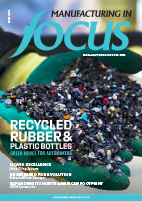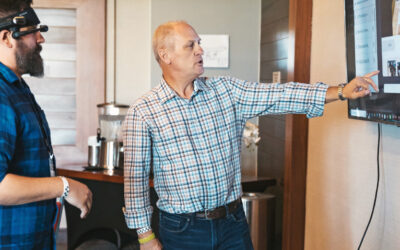Here in Canada, our affinity for dogs and cats is evidenced by the approximately eight million each of dogs and cats that we consider household pets, according to the Canadian Animal Health Institute (CAHI).
Those who truly love animals rejoice when a new pet becomes a part of our family and grieve when they pass on. Family pets provide companionship, humour, and loyalty and are proven to help reduce stress, depression, and risk of coronary artery disease. For these reasons alone, it is in an owner’s best interest to ensure that their four-legged companions live long, healthy, and content lives, the same lives we would wish for ourselves and our families.
Wanting to help pets to live long, healthy lives led to the establishment of Big County Raw (BCR) in 2012. This nutritionally safe, raw dog and cat food manufacturer in Smithville, Ontario has a current staff of approximately seventy-five.
BCR was founded by husband and wife team of Rob and Geraldine Brouwer, who began breeding dogs, specifically Bernese Mountain Dogs and German Short-haired Pointers, as a hobby in 2005 at Big Country Kennels. Their kennel is still in operation, run by Geraldine’s sisters.
The purchase of a nine-month-old puppy from a Bernese Mountain Dog breeder, originally from Switzerland and living in Quebec, changed everything for the Brouwers, enabling them to establish and grow BCR to revenues of nearly $20 million in business.
The Quebec breeder, a devoted advocate of feeding her dogs a raw-food diet, suggested the Brouwers do the same for healthier, more vibrant dogs and sent the couple home with information and recipes on how to feed their new puppy in a whole new manner.
“We were in the breeding circuit, and we really wanted a beautiful foundation dog for our breeding program,” says Geraldine. She went to her local butcher and purchased a variety of products to feed the new puppy, intending to do so for a couple of weeks and then return to the original kibble diet. But after the two weeks of a raw food diet, she noticed a change in her puppy’s “coat, her stool size, and her breath,” and realized her dog was “so much healthier than all the other dogs we’ve ever owned.” Her other dog had allergies, but once placed on the raw food diet, also blossomed.
Passion drove the Brouwers to conduct their own research on how to feed pets and to comprehend how dogs’ digestive systems function and absorb nutrients. They began making raw food and suggested to those buying puppies from the kennel that a raw food diet was the best with instructions and recipes on preparation.
But since the new pet owners were finding it too expensive or difficult to make, Geraldine offered to sell her raw food products, since she was already preparing them. “That interest and demand grew, and we quickly realized that this could be a business,” she says.
“A dog is classified as an opportunistic carnivore, so it can survive on other edible food sources and derive nutrients from it,” says Geraldine. On the other hand, a cat is an obligate carnivore, which means that, theoretically, a dog could live on corn, but a cat would not survive. “That’s the difference between an opportunistic and obligate carnivore. But they both are classified as being carnivores.”
She explains that the ramifications of feeding puppies processed food generally do not surface until the dog is approximately five or six years old. That is the age at which health issues such as diabetes, obesity, joint issues, and cancer may arise, leading to expensive veterinary visits. Such ailments are not always linked to aging.
“There are lots of studies that have been done that have said that dogs that are eating a raw food diet live, on average, three years longer than a dog that’s been eating processed foods… Naturally speaking, a raw food diet is actually easier for your dog to digest. They have a fast-moving digestive system. The food itself is not highly processed.”
It is best to start with poultry protein from chicken, turkey, or duck and gradually add meat bone, organ meat, or fruits and vegetables “as your dog gets used to the raw food diet. Don’t offer too much variety or change things up too much,” explains Geraldine. “Keep things the same for the first couple of weeks, until the dog is eating well and doing well. Then add more variety.”
Big Country Raw offers a number of raw meat products that are all processed in Smithville and include chicken, beef, duck, rabbit, and fish. Geraldine says that BCR manufactures three lines of dog food “which are complete meals,” including a dinner formula consisting of prepared ground meat with bone, organ meat, and fruit and vegetables.
“We also have some popular blends in which we mix a lot of proteins together. Those are very signature to Big Country Raw. They’re recipes that were formulated by us and are unique to our brand.”
Thirdly, BCR delivers pure formulas for the ‘do-it-yourselfer.’ “For people that want something that’s just the meat bone and organ meat. No added fruit, vegetables or trace minerals,” continues Geraldine. These formulas may be used to introduce a dog to diet or for a dog with allergies and are very protein specific. She states for example, that the company’s rabbit formula is just that – rabbit meat, bone, and organ. “There’s no other protein mixed into it,” whereas a chicken dinner formula is primarily chicken with added beef protein.
Packaged raw meaty bones and an extensive line of supplements and raw dehydrated foods for those travelling with their dogs are also available. “They can just add water, and rehydrate it, and they then have a dehydrated food option.” Quail, duck eggs, goat milk, and bone broth are also available as frozen supplements.
Rob relates that BCR uses sixty to seventy very selective suppliers for its pet food products. “Our biggest requirements are that they have to be federally inspected by the Canadian Food Inspection Agency (CFIA). We do use a few smaller, provincially-inspected plants such as the Ontario Ministry of Food, Agriculture, and Rural Affairs (OMAFRA).”
Big Country Raw uses suppliers that are “in good standing,” continues Rob. “We do make an effort to visit our suppliers, and that’s part of our new hazard analysis and critical control points (HACCP) plan that we’re hoping to implement in 2020.”
HACCP ensures that all internal processes and hazards are documented to mitigate potential quality control issues through full traceability “from your suppliers all the way back to your finished product,” Rob adds. “Most of our suppliers we’ve been with for a very long time. I don’t tend to move around too much. The biggest priority for us is making sure that it’s locally sourced. With the exception of kangaroo and some lamb products, almost everything is sourced within Canada.”
Geraldine says that raw food has minimal processing and is simply ground and frozen. “There’s no heat and no extended processing of ingredients. The nutrients are all there.” The company followed the National Research Council (NRC) Nutrient Requirements for Adult Dogs and Puppies (2006) in the formulation of their raw food recipes. The American Association for Food Control (AAFCO), the governing body created by the FDA that regulates pet food, also follows NRC nutrient guidelines.
However, AAFCO was created by kibble companies for kibble and this presented a challenge for BCR initially, since raw food was different from the stipulations presented by AAFCO which require binders and carbohydrates in production. “So the AAFCO guidelines were really set up in order to accommodate how you would produce a pet food using things like corn, wheat, and things that don’t end up in raw pet food,” says Geraldine. “We really couldn’t meet a lot of the AAFCO requirements without making a lot of concessions in the raw food diet… We’re actually using a better or higher standard than AAFCO itself. So those are the guidelines we use to formulate our recipes.”
The company has over seven hundred retailers, four hundred of which are in Ontario alone. “We are coast to coast now. Ontario and Eastern Canada definitely has the largest saturation of retailers,” Rob says.
At the end of 2019, the company started branching out to western retailers and is gradually increasing its market reach into Alberta and British Columbia, with some smaller numbers in Manitoba and Saskatchewan. “But certainly, the British Columbia and Alberta stores are coming on quite quickly now.”
Big Country Raw moved into a new 28,000-square-foot facility in 2019 but has plans for a future expansion. “We certainly are growing,” says Geraldine, adding that the company now has distribution centers in Ottawa and Montreal. “Hopefully, by the end of this year, we’ll also have distribution points on the east and west coast as well.”
This facility was built in collaboration with Integrated Food and Beverage, a design-build company based in Cambridge, Ontario. “They heard about our business and what we were doing and were most agreeable to help us design a building that would meet all the requirements if we were ever to be federally inspected ourselves,” explains Geraldine. The facility is “the first of its kind in Canada for any raw food pet company.”
Education is part of the pivotal role BCR plays to “educate our customers and our retailers,” states Geraldine. “We manufacture the product, and we also ship and deliver our product. We do it all… In the pet specialty particularly, it really goes against the general model of how things are done.” This unique business model has allowed for accelerated growth as the D2C business model allows BCR to respond quickly to customer and market demands on items such as product selection, pricing and even packaging.
The company used to use plastic packaging because it was readily available, but since moving into the new plant, a partnership was formed with StanPac Packaging, also in Smithville. StanPac manufactures with sustainable forestry products. “We decided that would be an excellent partnership,” says Geraldine. “It was our own personal conviction to start eliminating the resources that we as a family and personally are using and taking that same initiative into our business.”
Geraldine affirms that the industry itself needs to aggressively engage in “consumer education, especially the veterinarian communities,” to get rid of the stigma of raw food being dangerous and help them to understand that raw pet food is “scientific, nutritionally-based food, and it’s safe and healthy for pets.”
In the past few years, more veterinarians are advocating for a raw pet food diet, especially when supplied by Big Country Raw “because of the steps we have taken to make sure it’s safe, balanced and complete,” she concludes.













